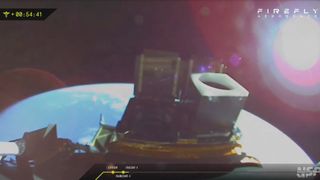Firefly Aerospace's Alpha rocket launched for the fifth time ever early Thursday morning (July 4), sending eight cubesats to orbit.
The mission, which Firefly called "Noise of Summer," launched from California's Vandenberg Space Force Base at 12:04 a.m. EDT (0404 GMT; 9:04 p.m. on July 3 local California time).
That was two days later than originally planned; an attempt early Tuesday morning (July 2) was scrubbed due to issues with ground support equipment, and Firefly took another day after that to continue analyzing the issue.

"Noise of Summer" sent eight cubesats toward low Earth orbit atop the 95-foot-tall (29-meter-tall) Alpha. The little spacecraft were selected via NASA's Cubesat Launch Initiative, which aims to help pave a path to space for satellites developed at U.S. colleges, universities and nonprofit organizations.
The eight cubesats that went up on "Noise of Summer" were developed by teams at the University of Arizona, the University of Kansas, the University of Maine, the University of Washington, a nonprofit called Teachers in Space, and two NASA facilities — Johnson Space Center in Houston and Ames Research Center in Silicon Valley.
All eight were scheduled to deploy by 55 minutes after launch. By about an hour after liftoff, Firefly had confirmed that seven had indeed separated as planned; the mission team was still working to determine if the University of Arizona craft, known as CatSat, had deployed as well.
"Noise of Summer" was also designed to demonstrate Firefly's ability to respond quickly to a launch directive.
Get the Space.com Newsletter
Breaking space news, the latest updates on rocket launches, skywatching events and more!
The company conducted the mission "as another responsive space operation, which includes transporting the payload fairing to the launch pad and mating it to Firefly's Alpha rocket within hours of the scheduled liftoff, compared to weeks in a typical operation," Firefly wrote in a mission description.
Firefly is practiced in such expedited activity. In September 2023, for example, the company launched the "Victus Nox" mission for the U.S. Space Force just 27 hours after receiving the official order — the fastest such turnaround for any national security mission, according to the company.
Alpha debuted in September 2021, on a test flight that failed shortly after liftoff. The rocket's second mission, in October 2022, was a partial success; it delivered seven satellites to orbit but apparently deployed them too low.
Alpha aced its third mission, the aforementioned "Victus Nox." Flight number four, which launched on Dec. 22 of last year, was more of a mixed bag. The rocket delivered its payload, an electronically steerable antenna developed by aerospace giant Lockheed Martin, to low Earth orbit but did not achieve the target orbit.
Still, Lockheed Martin was able to "successfully complete their primary mission objectives, including rapid commissioning of the satellite following insertion," Firefly wrote in an update about the mission in February.
Editor's note: This story was updated at 12:30 p.m. EDT on July 2 with news of the scrubbed first attempt and the new launch target date of July 3. It was updated again at 2:40 am ET on July 4 with news of launch of successful deployment of at least seven of the eight payloads.
Join our Space Forums to keep talking space on the latest missions, night sky and more! And if you have a news tip, correction or comment, let us know at: community@space.com.

Michael Wall is a Senior Space Writer with Space.com and joined the team in 2010. He primarily covers exoplanets, spaceflight and military space, but has been known to dabble in the space art beat. His book about the search for alien life, "Out There," was published on Nov. 13, 2018. Before becoming a science writer, Michael worked as a herpetologist and wildlife biologist. He has a Ph.D. in evolutionary biology from the University of Sydney, Australia, a bachelor's degree from the University of Arizona, and a graduate certificate in science writing from the University of California, Santa Cruz. To find out what his latest project is, you can follow Michael on Twitter.
Most Popular

